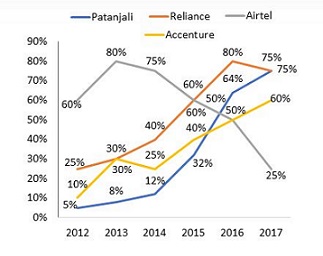 Introduction
Introduction
Data Interpretation is the ability to analyse, interpret and visualise the provided data to arrive at conclusions and to make inferences. Data Interpretation questions in the competitive exams is a test of analytical abilities. In the competitive exams, the Data Interpretation questions are grouped together and refer to the same table, graph or other data/visual presentation. The test takers are required to interpret or analyse the given data to answer the questions. In India, competitive exams related to employment in Banking, SSC, Insurance, etc..have the Data Interpretation type of questions. The article IBPS PO Mains Data Analysis and Interpretation Quiz 1 provides Data Interpretation Practice Quizzes with solutions.
 Quiz
Quiz
Directions (1-5): Study the following line chart carefully and answer the questions given beside.
The following line graph gives information about the percentage increase in the turnover of four companies (Patanjali, Reliance, Airtel, and Accenture) during the year 2012 to 2017 with respect to the previous year.
1. If at the end of the year 2011, the turnover of Patanjali was 25% less than the turnover of Airtel then at the end of 2014, the turnover of Patanjali was how much percent less than the turnover of Airtel? (approximately)
-
A. 40%
B. 60%
C. 51%
D. 81%
E. 85%
-
A. $ 12.25 billion
B. $ 14.21 billion
C. $ 7.48 billion
D. $ 9.64 billion
E. $ 6.14 billion
-
A. $ 6.21 billion
B. $ 7.21 billion
C. $ 4.58 billion
D. $ 3.12 billion
E. $ 2.24 billion
-
A. [latex]\frac{40}{21}[/latex] : [latex]\frac{28}{5}[/latex] : [latex]\frac{7}{2}[/latex] : [latex]\frac{50}{11}[/latex]
B. [latex]\frac{40}{21}[/latex] : [latex]\frac{27}{5}[/latex] : [latex]\frac{5}{2}[/latex] : [latex]\frac{50}{11}[/latex]
C. [latex]\frac{40}{21}[/latex] : [latex]\frac{28}{5}[/latex] : [latex]\frac{5}{2}[/latex] : [latex]\frac{40}{11}[/latex]
D. [latex]\frac{20}{21}[/latex] : [latex]\frac{14}{5}[/latex] : [latex]\frac{5}{4}[/latex] : [latex]\frac{25}{11}[/latex]
E. None of these
-
A. 450%
B. 500%
C. 600%
D. 550%
E. 300%
Directions (1-5): Refer to the graph and answer the given questions.Data related to the number of shirts sold by two stores (A and B) during 5 months:
1. What is the respective ratio between the total number of shirts sold by store B in January and February together and that by the same store in April and May together?
-
A. 10 : 9
B. 7 : 5
C. 5 : 3
D. 3 : 2
E. None of these
-
A. 270
B. 220
C. 260
D. 240
E. 230
-
A. 39 [latex]\frac{1}{3}[/latex]
B. 41 [latex]\frac{2}{3}[/latex]
C. 47 [latex]\frac{2}{3}[/latex]
D. 43 [latex]\frac{1}{3}[/latex]
E. 45 [latex]\frac{2}{3}[/latex]
-
A. 680
B. 690
C. 650
D. 670
E. 660
-
A. 415
B. 400
C. 180
D. 395
E. 425
Directions (1-5): Study the following table chart carefully and answer the questions given beside.
TATA, A car manufacturing company, has five manufacturing units A, B, C, D, and E in India where it manufactures two models of cars (Nano and Sumo). The following tables gives the information about the production capacity of the five manufacturing units of India for the year 2017. Capacity Utilization is the actual production in a year expressed as a percentage of the Production Capacity of the given manufacturing units in that year.
1. Which manufacturing units has the absolute maximum difference between the total production of Nano and that of Sumo in the year 2017?
| Nano | Sumo | |||
|---|---|---|---|---|
| Manufacturing units | Production Capacity (In 1000 units) | Capacity Utilization (In %) | Production Capacity (In 1000 units) | PCapacity utilization (In %) |
| A | 36 | 40% | 34 | 80% |
| B | 32 | 50% | 28 | 60% |
| C | 20 | 80% | 28 | 70% |
| D | 60 | 30% | 75 | 95% |
| E | 42 | 90% | 62 | 70% |
-
A. A
B. B
C. C
D. D
E. E
-
A. 37000
B. 27000
C. 18000
D. 42000
E. 42000
-
A. 40%
B. 45%
C. 35%
D. 25%
E. 48%
-
A. 280250
B. 280450
C. 280350
D. 280540
E. None of these
-
A. 55%
B. 60%
C. 74%
D. 83%
E. 92%







